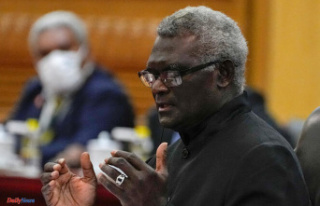The mobilization has been going on since the end of February. At the call of an inter-union bringing together the FSU, the CGT-Educ'action, SUD-Education, and the Federation of Education Workers, several days of strike and demonstration followed one another in Seine-Saint-Denis. The slogan is twofold: the abandonment of the “knowledge shock” policy, desired by the government, and the obtaining of an “emergency plan” of 358 million euros for the department.
This mobilization was amplified by the initiative of twelve mayors of the department who issued a joint decree on April 2 to urge the State to act against the lack of teachers and resources, and therefore to respond to inter-union demands. .
The “93” appears in fact to be the aggregator of difficulties existing elsewhere in France: phenomenon of school segregation, crisis of recruitment and replacement of teachers, but also of school doctors, or even degraded buildings. Several recent reports document in figures the particular difficulties that schools encounter in the youngest department of mainland France, and also among the poorest. Schools and colleges which are, for the most part, classified as REP/REP under public priority education policies deployed since the 1980s, policies which must result in additional investments.
A parliamentary report by deputies Christine Decodts (Renaissance, Nord) and Stéphane Peu (French Communist Party, Seine-Saint-Denis), published in November 2023, concludes that the school is “struggling to keep the republican promise” in the department and this despite the “Stronger State in Seine-Saint-Denis” plan announced in 2019.
Just ahead of Aisne, Ardennes and Haute-Marne, the public colleges of "93" have the lowest social position index (IPS) in mainland France, which means that the students there have the family environment considered the least favorable to academic success in the country.
This indicator, developed since 2016 by the Directorate of Evaluation, Foresight and Performance (DEPP) of the Ministry of National Education, is increasingly used to analyze the social situation of middle and high schools, and thus contributes to the debate on school diversity. The IPS is based on the allocation to each socio-professional category of an index calculated from several factors (such as the level of diploma or the material conditions of existence of a family) having an impact on the academic success of children.
The situation of Sequano-Dionysian public colleges is aggravated by the “flight” of the department’s wealthiest households to private education. “School avoidance appears to be moderate in volume, but very marked socially,” recalls the department, specifying that more than 30% of students educated in the private sector are children from a family whose parents belong to the CSP. In total, 13,500 middle school students living in the department, or 13% of students, are educated privately; 11,500 are registered in the private sector under contract in the territory and 2,070 in the Parisian private sector. In its studies, the DEPP notes that the social position index of private colleges under contract in Seine-Saint-Denis is similar to that of private establishments in the rest of France.
The department thus illustrates on the scale of a restricted territory the phenomenon of school segregation which crosses the country, in other words "the unequal distribution of students between educational establishments according to their individual characteristics, for example their social environment", as sums it up by economist Youssef Souidi, postdoctoral student at Paris Dauphine-PSL University, author of Vers la secession scolaire? Mechanics of segregation in middle school (Fayard, 232 pages, 14.99 euros). “In “93”, residential diversity is not necessarily accompanied by diversity in establishments: neighboring students, but with different social characteristics, have a high probability of not attending the same college,” underlines the researcher .
Seine-Saint-Denis tends to be a temporary assignment for civil servants, many of whom start there without knowing it. At the start of the 2022 school year, 34% of middle and high school teachers had less than two years of seniority in their establishment, according to the rectorate of the Créteil academy. Although this figure has been in constant decline since 2018, it remains 5 points higher than the national average.
The economic and social problems of students that teachers face while they lack experience and the lack of image of the department would create the conditions for their rapid departure but also for difficulty in recruiting, particularly in primary education, even though the need for new teachers is significant.
“There is a shortage of teachers for the same reasons as elsewhere in France, namely a salary drop which devalues the profession. Added to this is the tendency of candidates for teaching – both in primary and secondary education – to favor their region of origin, which serves the “93”", analyzes Stéphane Bonnéry, university professor of science of education at the University of Paris VIII-Saint-Denis.
The result is the increased use of contract workers. There were 952 in primary education at the start of the 2023 school year, or 8% of the workforce, compared to 808 in 2022, and 577 in 2021. In secondary education, this rate rises to 13% of the teaching workforce.
Seine-Saint-Denis still stands out for its high percentage of teachers who are not replaced when they are absent due to sickness, maternity or training leave. To the point of causing a loss of school time.
From 2018, the parliamentary report by deputies François Cornut-Gentille (Haute-Marne, Les Républicains) and Rodrigue Kokouendo (Seine-et-Marne, La République en marche) on the evaluation of state action in Seine- Saint-Denis uses the estimates of the Federation of Parents' Councils (FCPE 93) on this loss, which would amount on average to one year over the entire schooling of children in Seine-Saint-Denis. And to conclude: “The profusion of resources of REP and REP establishments loses its meaning if, in the end, the children of these establishments in difficult areas, who need them the most, benefit from fewer lessons than the others. »
Added to this is the alarming situation of school medicine. “In Seine-Saint-Denis, only seventeen out of fifty school doctor positions are filled,” notes the report by deputies Christine Decodts and Stéphane Peu.
According to the Education inter-union count, there is a shortage of a school nurse or doctor in 48% of schools, 40% of middle schools and 35% of high schools in the department, i.e. some 128 unfilled positions, to which are added 72 missing positions. social workers. “This professional body has been gradually dismantled since the 1990s, with non-replacement of retirements and unfavorable working conditions,” points out researcher Stéphane Bonnéry.
The July 2023 report taking stock of priority education highlights that the compulsory medical examination at age 6 to be carried out by the national education doctor (in order to detect specific language and learning disorders) did not concern , in 2022, only 21% of REP students and 21.5% of REP students.
Water damage, presence of pests, underheated premises, dilapidated toilets... The Education inter-union lists a series of failures which affect first and second level establishments. It calls for additional public investment in support of municipalities (responsible for schools), the department (colleges) and the region (high schools). The communities say they are determined to renovate, but suffer from a lack of resources, compared to other departments that have not experienced the same demographic growth. The department estimates, for example, that it needs a state envelope of 240 million euros to help it act over the next six years.
“The “93” colleges are hit by a sort of double punishment,” summarizes economist Youssef Souidi. The department having faced the demographic explosion over the last fifteen years, it was necessary to build a lot, but with the consequence of leaving few resources available for other educational expenses, even though the social difficulties are greater than in other departments. »












